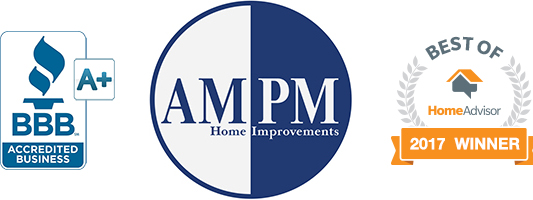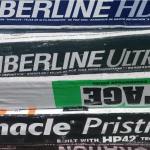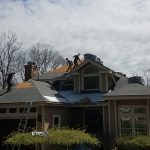
ROOFING FAQS
Below are roofing FAQs and answers to help you understand any facet of the roofing repair and replacement process in Connecticut.
Sooner or later, every roof needs to be replaced, usually due to the long-term effects of weathering. If a residential roof is more than 20 years old, it is a prime candidate for reroofing. To determine if you need a new roof:
On the ground, walk around your home with binoculars and inspect your roof for cracked, curled or missing shingles, as well as any excessive loss of the protective mineral granules. DO NOT CLIMB ON THE ROOF; walking on the roof is dangerous and can damage your roof.
In your attic, take a flashlight and look at the underside of the roof deck and rafters for any stains or wet spots indicating water leaks.
Asphalt shingles can often be applied directly over existing roofs without the necessity of tearing off the old roof. However, new shingles can not be properly applied over hard or brittle materials, uneven surfaces for nailing or roof decks with warped, rotted or unsound support that should first be replaced or repaired.
Some local ordinances forbid reroofing over two or more layers of shingles. If a home already has been shingled several times, it is important to first determine if the roof deck can support another layer of shingles before undertaking any re-roofing project.
All too often, roof system problems are discovered after leaking or other serious damage occurs. Periodic (twice-a-year) inspections often can uncover cracked, warped or missing shingles; loose seams and deteriorated flashings; excessive surface granules accumulating in the gutters or downspouts; and other visible signs of roof system problems. Indoors, look for cracked paint, discolored plasterboard and peeling wallpaper as signs of damaged roof areas.
You have two basic options: You can choose a complete replacement of the roof system, involving a tear off of your existing roof system, or re-cover the existing roof system, involving only the installation of a new roof system. If you’ve already had one re-cover installed on your original roof system, check with a professional roofing contractor. In many instances, building code requirements allow no more than one roof system re-cover before a complete replacement is necessary.
Roofing options are plentiful today with new products, styles, and colors being developed regularly. For the most up-to-date roofing colors, roofing styles and roofing products, visit our showroom. We can provide roofing samples for asphalt shingle roofing, composite roofing, slate roofing, cedar roofing, metal roofing and copper roofing.
Not necessarily. Leaks can result from flashings that have come loose or a section of the roof system being damaged. A complete roof system failure, however, generally is irreversible and a result of improper installation or choice of materials or the roof system installation is inappropriate for the home or building.
Most work should not be done yourself. Professional roofing contractors are trained to safely and efficiently repair or replace roof systems. You can damage your roof system by using improper roofing techniques and severely injure yourself by falling off or through the roof. Maintenance performed by home and building owners should be confined to inspecting roof systems during the fall and spring to check for cracked or curling shingles and cleaning gutters filled with dead leaves and other debris. If you must inspect your roof system yourself, use a firmly braced or tied-off ladder equipped with rubber safety feet. Wear rubber-soled shoes and stay on the ladder (and off the roof system), if possible.
Most new roof systems are designed to provide useful service for about 20 years. Some roof system types, such as composite, slate, clay tile and certain metal (e.g., copper) systems, can last longer. Actual roof system life span is determined by a number of factors, including local climatic and environmental conditions, proper building and roof system design, material quality and suitability, proper application and adequate roof maintenance. Roofing product manufacturers offer a variety of warranties on their products. Take a close look at those warranties to see what responsibilities and financial obligations manufacturers will assume if their products fail to reach their expected lives.
Yes. You can apply new shingles over existing shingles, depending on the condition of the roof. If the roof has one layer of shingles that are lying flat and the deck is in good condition, the existing shingles typically do not have to be removed. Check with local officials to make sure that building codes are being followed. During re-roofing is a good opportunity to examine roof ventilation to ensure vents are sufficient in number, positioned properly and are unobstructed.
Algae growth is typically seen on light colored shingles. It exists as a brown to black discoloration of the shingle and is caused by an algae known as Gloeocapsa.
Although algae may exist on a shingle, it does not affect the performance of the shingle. Essentially, this is an aesthetic problem.
Hail can affect asphalt roofing shingles. The damage caused by hail can be classified into two groups: aesthetic damage and functional damage. Aesthetic damage results in slight granule loss and the life of the shingle is usually not affected. Functional damage is characterized by substantial granule loss or cracking or penetration of the shingle. Functional damage may result in short term leaks or a reduction of the life expectancy of the shingle.
The shingles must have a minimum solar reflectance (tested right out of the package and again after three years on the roof) and a comparable (with non-approved shingles) limited warranty program. It is assumed that better shingle solar reflectance, if used on every roof within an urban area, may reduce the overall temperature in cities (heat island effect), which in turn would lower the energy load needed for air conditioning. In terms of the practical benefit to the individual home directly, shingle color is irrelevant to home heating and cooling costs since the attic floor is typically well-insulated and the attic is also ventilated. Note that in Canada, Energy Star ratings do not apply, as per Natural Resources Canada.
There may be some tax advantages with using ENERGY STAR™ approved roofing shingles in some areas; check with your local government.
Asphalt shingles are the leading choice for residential roofing in the United States because they provide quality, durability, versatility and economy. Over 12.5 billion square feet of asphalt shingle products are manufactured annually – enough to cover more than 5 million homes every year. Four out of five homes are roofed with asphalt shingles.
Asphalt shingles offer consumers the broadest array of colors, shapes, and textures available. With an enormous range of styles, asphalt shingles can match almost every type of architectural design and achieve virtually any desired effect – and do it affordably.
Product Performance. Asphalt shingles perform well in extreme temperatures and in areas where wind, water, and ice are prevalent.
Affordability. The efficient, high-volume production and relatively low application cost of asphalt shingles provide consumers with an overall value that’s tough for other roofing materials to match, especially in terms of comparable life expectancy.
Low Maintenance. Asphalt shingles, when properly chosen and applied, require little or no regular upkeep, and are easily repaired if damaged.
Ease of Application. Asphalt shingles are considered to be the easiest of all standard roofing materials to apply. In addition, the flexibility and strength of asphalt shingles supports their application on a wide variety of roof designs.
Fire and Wind Resistance. Asphalt shingles are manufactured to resist external fire and flammability standards, and carry Class A, B or C fire ratings, with Class A providing the greatest fire resistance. These fire ratings are defined by nationally recognized standards and tested by independent testing agencies. In addition, many asphalt shingles carrying a “wind resistance” label indicate that they have been manufactured and tested to demonstrate acceptable resistance in high-wind locations.”
Strip Shingles. These asphalt shingles are approximately three times as long as they are wide. Manufactured in both standard and metric dimensions, strip shingles are distinguished by the number of cutouts or tabs that they have. The most common type of strip shingle is the “three-tab” shingle. Different textural and lighting/shadowing effects can be achieved with strip shingles depending on the number, shape and alignment of the cutouts.
Laminated Shingles. These special shingles contain more than one layer of tabs to create extra thickness. They are also referred to as three-dimensional or architectural shingles because they create visual depth on a roof and impart a custom look. Laminated shingles continue to be a favorite among builders, roofing contractors and homebuyers.
Interlocking Shingles. As the name suggests, interlocking asphalt shingles are individual shingles that mechanically fasten to each other, and are used to provide greater wind resistance. They come in various shapes and sizes providing a wide range of design possibilities.
Large Format Shingles. Generally rectangular or hexagonal in shape, these shingles do not utilize cutouts or tabs.
Schedule Free Estimate
AM PM roofing solutions for your home
Let Us Help You!
AM PM Roofing has the experience, licenses, skills, and materials to provide you with expert roofing solutions in Connecticut. We have been providing expert roofing, gutter, siding, and chimney services in Connecticut for over 30 years, and are a BBB A+ Rated Roofing Company.
Schedule A Roof Estimate
Schedule a Free Roof Estimate for roof replacement in Hartford, Middlesex, New Haven, New London, and Tolland counties today! Call (860) 346-2676 or submit Free Estimate Request online, or call with your Roofing FAQs.
OUR SERVICE AREAS
Middlesex County
Roofing FAQs Centerbrook, Chester, Clinton, Cobalt, Cromwell, Deep River, Durham, East Haddam, East Hampton, Essex, Haddam, Higganum, Ivoryton, Killingworth, Middlefield, Middletown, Moodus, Old Saybrook, Portland, Rockfall, Westbrook CT.
New London County
Roofing FAQs Baltic, Bozrah, Colchester, East Lyme, Franklin, Gales Ferry, Gilman, Griswold, Groton, Lebanon, Ledyard, Lisbon, Lyme, Mashantucket, Montville, Mystic, New London, Niantic, North Franklin, North Stonington, Norwich, Oakdale, Old Lyme, Old Mystic, Pawcatuck, Preston, Quaker Hill, Salem, Sprague, Stonington, Uncasville, Waterford, West Mystic, Yantic CT.
Hartford County
Roofing FAQs Avon, Berlin, Bloomfield, East Hartford, East Windsor, Enfield, Farmington, Glastonbury, Granby, Hartford, Marlborough, Manchester, Newington, Plainville, Rocky Hill, Simsbury, Southington, South Windsor, West Hartford, Wethersfield, Windsor, Windsor Locks CT.
New Haven County
Roofing FAQs Branford, Cheshire, East Haven, Guilford, Hamden, Madison, Meriden, New Haven, North Branford, North Haven, Wallingford CT.
Tolland County
Roofing FAQs Andover, Bolton, Columbia, Coventry, Ellington, Hebron, Tolland, Vernon CT.









